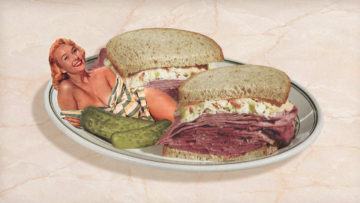Josie Delap in More Intelligent Life:
 What would you rather have: an orgasm or a pastrami sandwich? The woman at the table next to Meg Ryan and Billy Crystal in Katz’s Delicatessen in “When Harry Met Sally” chose poorly. She plumped for the turkey sandwich that seemed to have inspired Sally’s simulated raptures. She should have picked what he was having: the pastrami.
What would you rather have: an orgasm or a pastrami sandwich? The woman at the table next to Meg Ryan and Billy Crystal in Katz’s Delicatessen in “When Harry Met Sally” chose poorly. She plumped for the turkey sandwich that seemed to have inspired Sally’s simulated raptures. She should have picked what he was having: the pastrami.
Pastrami on rye is the platonic ideal of the New York deli sandwich. The version Harry demolished as Sally educated him in the ways of womankind was oddly modest. He was able to get his chops around it with little effort and no mess. A perfect pastrami sandwich should be large enough to inspire a certain apprehension. It is testimony to the Jewish fear that someone, somewhere might at some point go hungry.
Jews did not invent pastrami. In Ottoman Turkey, basturma or pastirma was a kind of pressed, spiced meat – beef, goat or mutton – not unlike jerky. It may have been produced by horse riders stashing the beef in their saddlebags and pressing it with their thighs as they rode. The recipe travelled along the spice route to Romania, where goose became the meat of choice.
The late 19th century and early 20th century saw a surge of Jewish immigrants to New York from across eastern Europe, including Romania. An earlier rush of German migrants to the east coast had brought a delectable range of smoked and cured meats and sausages. When Romanian Jews introduced the pastrami, they soon abandoned the traditional goose in favour of beef, which was cheaper and more readily available.
More here.
